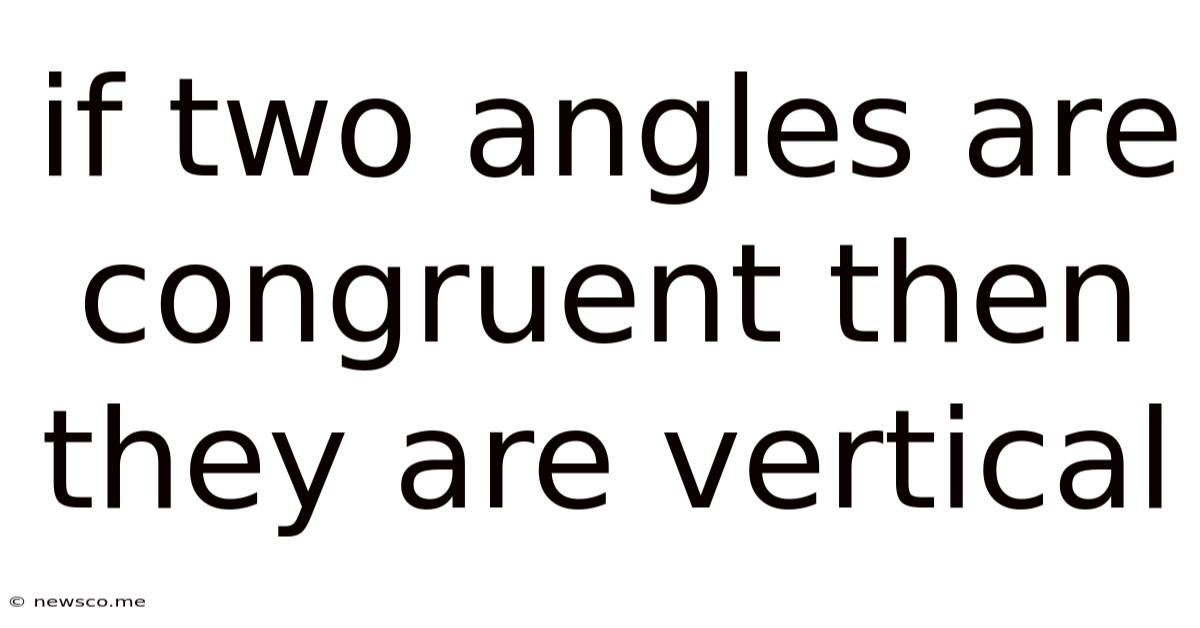If Two Angles Are Congruent Then They Are Vertical
News Co
May 03, 2025 · 5 min read

Table of Contents
If Two Angles Are Congruent, Then They Are Vertical: Exploring the Misconception
The statement "If two angles are congruent, then they are vertical" is incorrect. While vertical angles are always congruent, the converse is not true. Congruent angles can exist in numerous geometric configurations, and their vertical relationship is just one specific case. This article delves deep into the understanding of angles, their types, and the critical distinction between congruent angles and vertical angles. We'll explore various examples and counter-examples to solidify this understanding.
Understanding Angles and Their Types
Before diving into the misconception, let's establish a solid foundation. An angle is formed by two rays sharing a common endpoint called the vertex. Angles are measured in degrees, ranging from 0° to 360°. We categorize angles based on their measures:
- Acute Angle: An angle whose measure is between 0° and 90°.
- Right Angle: An angle whose measure is exactly 90°.
- Obtuse Angle: An angle whose measure is between 90° and 180°.
- Straight Angle: An angle whose measure is exactly 180°.
- Reflex Angle: An angle whose measure is between 180° and 360°.
Congruent Angles: The Definition
Two angles are considered congruent if they have the same measure. This means that if angle A measures 45°, and angle B also measures 45°, then angles A and B are congruent. The symbol for congruence is ≅. So, we would write: ∠A ≅ ∠B. Crucially, congruent angles don't have to be in any specific spatial relationship to each other. They can be located anywhere in a diagram, as long as their measures are identical.
Vertical Angles: A Specific Case of Congruence
Vertical angles are formed when two lines intersect. They are the non-adjacent angles created at the intersection point. A critical property of vertical angles is that they are always congruent. This is a proven geometric theorem. If you have lines AB and CD intersecting at point O, then ∠AOD and ∠BOC are vertical angles, as are ∠AOC and ∠BOD. Because they are vertical angles, we know: ∠AOD ≅ ∠BOC and ∠AOC ≅ ∠BOD.
Why are vertical angles congruent? This stems from the fact that adjacent angles on a straight line are supplementary (they add up to 180°). Let's consider ∠AOD and ∠AOC. They are adjacent and form a straight angle, so:
m∠AOD + m∠AOC = 180°
Similarly, ∠AOC and ∠BOC are adjacent and form a straight angle:
m∠AOC + m∠BOC = 180°
By subtracting the second equation from the first, we get:
m∠AOD - m∠BOC = 0
Therefore, m∠AOD = m∠BOC, proving that vertical angles are congruent.
Counterexamples: Congruent Angles That Are Not Vertical
The core of the misconception lies in assuming that congruence implies a vertical relationship. Let's examine some examples where congruent angles are not vertical angles:
Example 1: Parallel Lines and Transversals
Consider two parallel lines intersected by a transversal. This creates several pairs of congruent angles: corresponding angles, alternate interior angles, and alternate exterior angles. These congruent angles are not vertical angles; they have different geometric relationships.
Example 2: Isosceles Triangles
In an isosceles triangle, the two angles opposite the equal sides are congruent. These congruent angles are clearly not vertical angles; they are adjacent angles within the triangle.
Example 3: Regular Polygons
A regular polygon has all its sides and angles equal. Any two angles within a regular polygon are congruent, but they are not vertical angles unless the polygon is a quadrilateral, where opposite angles might sometimes be vertical.
Example 4: Multiple Intersections
Imagine a scenario where multiple lines intersect, forming numerous angles. Many pairs of these angles might be congruent without being vertically opposite.
Visual Representations and Diagrams
Using diagrams is crucial for understanding this concept. Draw several diagrams depicting congruent angles in various geometric contexts – triangles, quadrilaterals, intersecting lines (both parallel and non-parallel), and combinations thereof. Label the angles clearly and indicate their measurements to show congruence. Avoid just showing vertical angles; actively showcase congruent angles that are not vertical to strengthen your understanding of the distinction.
The Importance of Precise Geometric Language
The confusion often arises from a lack of precision in geometric terminology. It’s essential to differentiate between congruent angles as a general property and vertical angles as a specific geometric configuration leading to congruence. Understanding the nuances of the language used in geometry is crucial for correctly interpreting and applying geometric theorems and principles.
Practical Applications and Real-World Examples
Understanding the difference between congruent and vertical angles isn't just an academic exercise; it has practical applications in many fields. Engineers, architects, and even graphic designers need to accurately calculate and understand angular relationships. Incorrect application of this principle could lead to errors in construction, design, and various other applications.
Conclusion: Congruence Does Not Imply Verticality
To reiterate, the statement "If two angles are congruent, then they are vertical" is definitively false. Congruence is a broader concept than verticality. While vertical angles are always congruent, the converse isn't true. Many configurations can create congruent angles without any vertical relationship. Through various examples and a careful analysis of definitions, we’ve clarified this misconception, emphasizing the importance of precise geometric language and critical thinking in problem-solving within geometry. Remember, always analyze the specific geometric relationships in a diagram before drawing conclusions about angle properties. Thorough understanding of these fundamental concepts is crucial for success in higher-level geometry and related fields.
Latest Posts
Related Post
Thank you for visiting our website which covers about If Two Angles Are Congruent Then They Are Vertical . We hope the information provided has been useful to you. Feel free to contact us if you have any questions or need further assistance. See you next time and don't miss to bookmark.